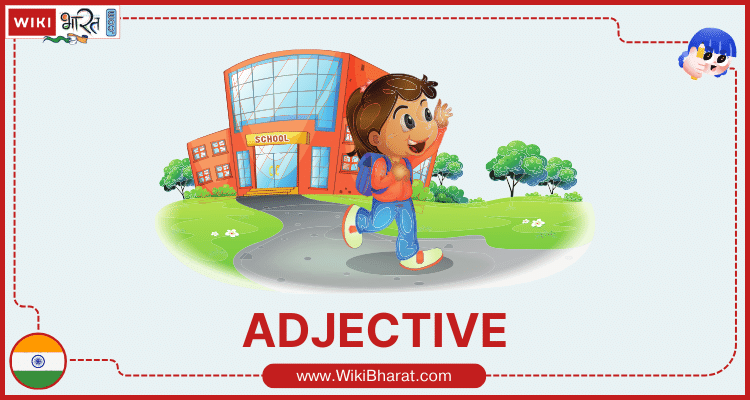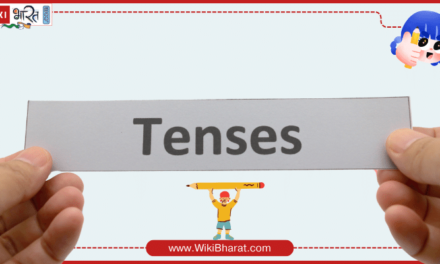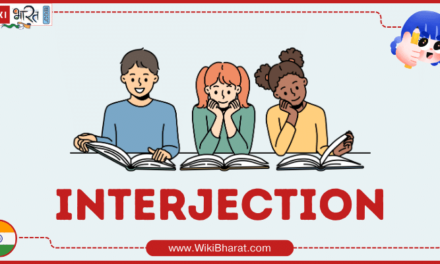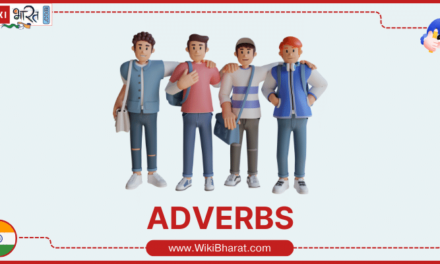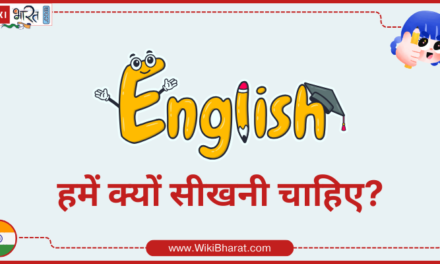Adjective in Hindi : Adjectives, जो अंग्रेजी व्याकरण के सबसे अहम पहलुओं में एक हैं, ये वे शब्द हैं जो हमें बताते हैं कि कोई चीज़ या व्यक्ति कैसा है। इन शब्दों का उपयोग हम किसी चीज़ का रंग, साइज, स्वाद, स्थिति, और अन्य विशेषताओं को व्यक्त करने में करते हैं।
आपने ये words सुने होंगे, जैसे “सुंदर,” “लाल,” “बड़ा,” या “मिठा”। ये सब Adjectives हैं, और ये हमें बताते हैं कि चीज़ें कैसी होती हैं। इस ब्लॉग में, आज हम एडजेक्टिव्स के बारे में और भी कुछ बातें जानेंगे, जैसे कि Adjective किसे कहते है?, Adjective Definition in Hindi, Adjective Meaning in Hindi, Types Of Adjective in Hindi एंव Adjectives के कुछ नियम ताकि हम अपनी भाषा को और बेहतर ढंग से समझ सकें। तो, तैयार रहिए English Grammar के इस सफर को जारी रखने के लिए…
Adjective Kise Kahate Hain
Adjective Definition in Hindi : Adjective एक ऐसा शब्द है जो किसी Noun या Pronoun की विशेषता बताने के लिए उपयोग किया जाता है।
Adjective Meaning in Hindi : वह सभी Words, जिनका उपयोग किसी Noun या Pronoun के बारे में या विशेषता बताने में किया जाता है, उन Words को Adjective के नाम से जाना जाता है।
जैसे, अगर आप किसी के बारे में बात कर रहे है फिर चाहे वह अच्छाई हो या बुराई, वह सभी Words Adjective कहलाते है।
इसको हम एक उदाहरण की मदद से समझते है,
- Rani is a beautiful girl.
इस उदाहरण में बताया गया है कि रानी Beautiful है यानि कि Beautiful शब्द यहां Rani की विशेषता बता रहा है जो कि Noun है और हमने अभी Adjective की परिभाषा में पढ़ा था, जो शब्द Noun या Pronoun के विशेषता बताते है वह Adjective होते है इसलिए Beautiful इस Sentence में एक Adjective है।
Note : Adjective का उपयोग हमेशा उस Noun या Pronoun के साथ होगा, जिसके बारे में बता रहा है।
विशेषणों के रूप – तुलना के डिग्री
Adjective में Degrees of Comparison क्या होता है?
क्या आप जानते हैं कि Adjectives का उपयोग विभिन्न विषयों के समान गुणों की तुलना के लिए भी किया जाता है, इस आधार पर इन्हे तीन रूपों में विभाजित किया गया है:
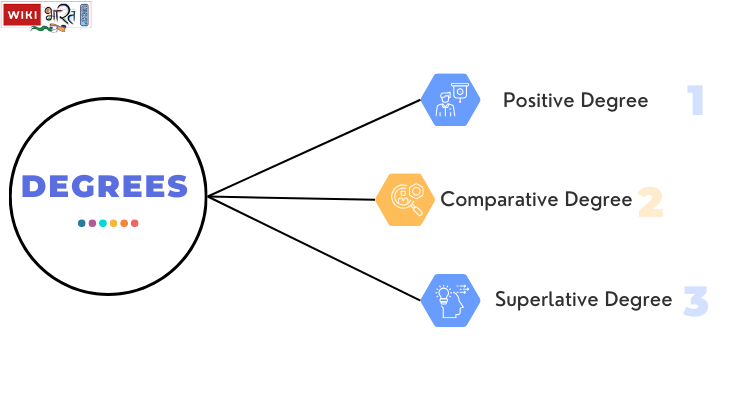
Positive Degree : Positive Degree का प्रयोग किसी व्यक्ति या वस्तु के गुण के लिए तब किया जाता है जब उसकी तुलना किसी से भी नहीं की जा रही हो, यानि कि किसी व्यक्ति या वस्तु के गुण में Original Form का उपयोग किया जा रहा हो। जैसे,
- Rahul is a smart guy.
- Mohan is a clever boy.
Comparative Degree : Comparative degree का प्रयोग दो व्यक्तियों या वस्तुओं के गुणों की तुलना करने के लिए किया जाता है। जैसे,
- Rahul is better than Mukesh.
- She is more intelligent than her sister.
Superlative Degree : Superlative degree का प्रयोग दो से अधिक व्यक्तियों या ‘वस्तुओं के गुणों की तुलना के लिए किया जाता है। जैसे,
- Radha is the most beautiful girl in the college.
- Ramesh is the wisest of all the five friends.
Adjective के प्रकार / Types Of Adjectives in Hindi
Adjectives को Sentence में उनके कार्यों के आधार पर विभिन्न श्रेणियों में वर्गीकृत किया जा सकता है, जो इस प्रकार है :
- Proper Adjectives
- Possessive Adjectives
- Distributive Adjectives
- Demonstrative Adjectives
- Numeral Adjectives
- Quantitative Adjectives
- Qualitative Adjectives
- Interrogative Adjectives
- Exclamatory Adjective
1) Proper Adjectives
Proper Noun से बनने बाले Adjectives को Proper Adjectives कहते है जैसे,
| Proper Pronouns | Proper Adjectives |
| India | Indian |
| America | American |
| Australia | Australian |
Note :- Proper Adjectives का पहला Letter हमेशा Capital रहना चाहिए।
2) Possessive Adjectives
Sentence में My, our, his, your, her, their और its के उपयोग को Possessive Adjectives कहा जाता है। याद रखे कि Possessive Adjectives का उपयोग हमेशा Noun से पहले किया जाता है।
ये एडजेक्टिव्स हमें बताते हैं कि किसकी चीज़ है, यानि कि ये Sentence में व्यक्ति के मालिकाना हक को दर्शाते हैं।
बेहतर समझ के लिए यहाँ कुछ उदाहरण हैं,
- My Car – इसमें “My” Possessive Adjectives है, जो दिखाता है कि कार मेरी है।
- Your Song – इसमें “Your” Possessive Adjectives है, जो दिखाता है कि गाना तुम्हारा है।
- Her Book – इसमें “Her” Possessive Adjectives है, जो दिखाता है कि किताब उसकी है।
ये Possessive Adjectives हमें वस्तुओं के मालिक को समझने में मदद करते हैं।
3) Distributive Adjectives
ये एडजेक्टिव्स हमें दिखाते हैं कि कुछ चीजें एक – एक या अलग-अलग तरीके से किसी समूह में होती हैं।
Sentence में Each, every, either, neither के उपयोग को Distributive Adjectives कहा जाता है।
(i) ‘Each’ का प्रयोग दो या दो से अधिक के लिए किया जाता है; जैसे
- Each of the students was punished.
(ii) ‘Every’ का प्रयोग हमेशा दो से अधिक व्यक्तियों या वस्तुओं के लिए किया जाता है; जैसे
- He gave every girl the same pen.
(iii) ‘Either’ या ‘Neither’ का उपयोग सिर्फ दो के लिए किया जाता है; जैसे
- There are two boys in the room. Neither boy is handsome.
(iv) Each, Every, Either, Neither के बाद प्रयुक्त Noun के पहले Article का प्रयोग नहीं किया जाता है।
बेहतर समझ के लिए, यहाँ कुछ उदाहरण हैं
Every child – इसमें “every” Distributive Adjectives है, जो बताता है कि हर एक बच्चा अलग है और हम एक-एक करके सभी बच्चों की बात कर रहे हैं।
Some flowers there – यहाँ “some” Distributive Adjectives है, ये हमें बता रहा हैं कि वहां कुछ फूल हैं, लेकिन कितने है नहीं जानते।
All toys – इसमें “all” Distributive Adjectives है, जो दिखाता है कि हम सभी खिलौनों की बात कर रहे हैं।
इस एडजेक्टिव्स के माध्यम से हम वस्तुओं को समूह में या एक-एक करके समझ सकते हैं जो हमारी भाषा को और भी स्पष्ट बना सकते हैं।
4) Demonstrative Adjectives
Demonstrative Adjectives हमें बताते हैं कि कुछ चीजें कहाँ हैं और हम किस चीज़ की बात कर रहे हैं।
Demonstrative Adjectives दो प्रकार के होते हैं –
(i) Definite : This, that, these, those, such, same. ये Adjectives किसी निश्चित व्यक्ति या वस्तु को दर्शाते हैं।
(ii) Indefinite : A, an, a certain, certain, some, any, any other, another, other. ये Adjectives किसी खास अर्थ में व्यक्ति या वस्तु के प्रदर्शन का काम करते हैं किन्तु निश्चितता के अर्थ में नहीं।
ध्यान रखें,
(i) A, an, a certain, another, this, that का प्रयोग हमेशा Singular Countable Noun के साथ किया जाता है; जैसे,
- This horse.
- A certain girl.
- This book
(ii) Such, the same, the other, any का प्रयोग Singular Countable Noun तथा Plural Countable Noun दोनों के लिए किया जाता है; जैसे,
- Such a girl, Such girls
- The same book, The same books
(iii) ‘These’, ‘those’ ‘certain’ का प्रयोग हमेशा Plural Countable Noun के साथ किया जाता है; जैसे
- These elephants,
- Those boys,
- Certain books
बेहतर समझ के लिए आइए, हम कुछ उदाहरणों को देखें,
This book – इसमें “this” Demonstrative Adjectives है, जो हमें बताता है कि किताब जो हमारे पास है, और किस किताब की बात हो रही है।
That house – यहाँ “that” Demonstrative Adjectives है, जो हमें बता रहा हैं कि घर जो हम देख रहे हैं, किस घर की बात हो रही है।
These flowers – इस तरह, “these” हमें दिखाता है कि हम किस फूल की बात कर रहे हैं, जो हमारे पास है।
ये Demonstrative Adjectives हमें चीज़ों की स्थिति को समझने में मदद करते हैं और हमारी भाषा को और स्पष्ट बनाते हैं।
5) Numeral Adjectives
Numeral Adjectives हमें बताते हैं कि कितनी चीजें हैं और वे कैसी हैं ये दो प्रकार के होते हैं।
(i) Definite : ऐसे Adjectives, जो व्यक्तियों या वस्तुओं की निश्चित संख्या (number) या क्रम (order) का बोध कराते हैं Definite Numeral Adjectives कहलाते हैं।
(a) निश्चित संख्या (number) का बोध कराने वाले Adjectives को Cardinals कहा जाता है; जैसे One, two, three, four etc.
(b) निश्चित क्रम (order) का बोध कराने Adjectives को Ordinals कहा जाता हैं; जैसे First, third, next, last, etc.
(c) यदि किसी Sentence में Cardinals तथा Ordinals का उपयोग करना हो तो पहले Ordinals का तथा बाद में Cardinals का प्रयोग किया जाता है; जैसे,
- The first three questions of this exercise.
(ii) Indefinite : ऐसे Adjectives, जो अनिश्चित संख्या का बोध कराते हैं, Indefinite Numeral Adjectives
कहलाते हैं; जैसे,
Many, some, enough, few, various, several, all, most ये सभी Numeral Adjectives हैं।
बेहतर समझ के लिए आइए, हम कुछ उदाहरणों को देखें,
One child – इसमें “one” Numeral Adjectives है, जो हमें बताता है कि एक बच्चा है, और हम कितने बच्चे की बात कर रहे हैं।
Two balloons – यहाँ “two” Numeral एडजेक्टिव है, जो हमें बताता है कि हम दो गुब्बारे की बात कर रहे हैं।
Five books – इस उदाहरण में, “five” Numeral एडजेक्टिव है, जो हमें बताता है कि हम पाँच किताबों की बात कर रहे हैं।
Numeral एडजेक्टिव्स Sentence में हमें चीजों की मात्रा और प्रकार को समझने में मदद करते हैं।
6) Quantitative Adjectives
Quantitative एडजेक्टिव्स हमें बताते हैं कि चीजों की कितनी मात्रा है और वे कैसी हैं यानि कि ऐसे adjective, जो मात्रा का बोध कराते हैं उन्हें Quantitative Adjectives कहा जाता हैं; जैसे,
- Much, many, little, fewer, whole, some, enough, all, most
(i) Much, little, whole का प्रयोग हमेशा मात्रा के लिए किया जाता है; जैसे,
- Much milk
- little sugar
- whole book
(ii) All, some, enough, sufficient, most आदि का प्रयोग मात्रा तथा संख्या दोनों के लिए किया जाता है।
बेहतर समझ के लिए आइए, हम कुछ उदाहरणों को देखें,
Some flowers – इसमें “some” Quantitative एडजेक्टिव है, जो हमें बताता है कि हम कुछ फूल देख रहे हैं, लेकिन हम नहीं जानते कितने हैं।
Many dogs – यहाँ “many” Quantitative एडजेक्टिव है, जो हमें बताता है कि हम बहुत सारे कुत्ते देख रहे हैं, और उनकी मात्रा को दर्शाता है।
Fewer cookies – इस उदाहरण में, “fewer” Quantitative एडजेक्टिव है, जो हमें बताता है कि बहुत कम खाना बचा है, जिससे ये खाने की मात्रा को दर्शा रहा है।
Quantitative एडजेक्टिव्स हमें चीजों की मात्रा और विशेषता को समझने में मदद करते हैं और हमारी भाषा को और स्पष्ट भी बनाते हैं।
7) Qualitative Adjectives
Qualitative एडजेक्टिव्स हमें बताते हैं कि चीजें कैसी हैं और उनकी गुणवत्ता क्या है यानि कि ऐसे Adjectives जो व्यक्तियों या वस्तुओं के आकार, आदि गुणों का बोध कराते हैं Qualitative Adjectives कहलाते हैं; जैसे,
- Big, small, good, bad, ugly, beautiful आदि।
बेहतर समझ के लिए आइए, हम कुछ उदाहरणों को देखें,
Beautiful flowers – इसमें “beautiful” Qualitative एडजेक्टिव है, जो हमें बताता है कि फूल कितने खूबसूरत हैं।
Big house – यहाँ “big” Qualitative एडजेक्टिव है, जो हमें बता रहा है कि घर कितना बड़ा है।
Happy child – इस उदाहरण में, “happy” Qualitative एडजेक्टिव है, जो हमें बताता है कि बच्चा कितना खुश है।
Qualitative एडजेक्टिव्स हमें चीजों के गुणवत्ता और विशेषता को समझने में मदद करते हैं और हमारी भाषा को और भी स्पष्ट बनाते हैं।
8) Interrogative Adjectives
Interrogative एडजेक्टिव्स हमें प्रश्न पूछने में मदद करते हैं और ये हमें किसी विशिष्ट वस्तु के बारे में जानने की इच्छा दिखाते हैं यानि कि जिन Adjectives का प्रयोग हम प्रश्न पूछने के लिए करते है उन्हें Interrogative Adjectives कहा जाता हैं; जैसे
- Which girl do you like most?
बेहतर समझ के लिए आइए, हम कुछ उदाहरणों को देखें,
Which fruit – इसमें “which” Interrogative एडजेक्टिव है, जो हमसे पूछता है कि कौन से फल की हम बात कर रहे हैं, जैसे कि आप किस प्रकार के फल को पसंद करते हैं।
How many people – यहाँ “how many” Interrogative एडजेक्टिव है, जो हमें पूछता है कि हम कितने लोगों की बात कर रहे हैं।
Whose house – इस उदाहरण में, “whose” Interrogative एडजेक्टिव है, जो हमें पूछता है कि घर किसका है, जैसे कि आप किसी के घर के बारे में जानना चाहते हैं।
Interrogative एडजेक्टिव्स हमें विशिष्ट वस्तु के बारे में जानने में मदद करते हैं, जब हम प्रश्न पूछते हैं।
9) Exclamatory Adjectives
Exclamatory एडजेक्टिव्स हमें बताते हैं कि हमें किस चीज़ के प्रति आश्चर्य हो रहा है और हम कितने प्रशंसा और हैरानी से बात कर रहे हैं यानि कि आश्चर्य का भाव प्रकट करने के लिए प्रयुक्त Adjective को Exclamatory Adjective कहा जाता है।
बेहतर समझ के लिए आइए, हम कुछ उदाहरणों के साथ देखें,
What a beautiful scene – इसमें “what” Exclamatory एडजेक्टिव है, जो हमें बताता है कि हमें यह दृश्य कितने अद्भुत और आश्चर्यजनक लग रहा है।
Wow, the fragrance – यहाँ “wow” Exclamatory एडजेक्टिव है, जो हमें बताता है कि खुशबू कितनी आदर्श और अच्छी है।
How thrilling a story – इस उदाहरण में, “how” Exclamatory एडजेक्टिव है, जो हमें बताता है कि कहानी कितनी रोमांचक है, जैसे कि हमें सचमुच अद्भुत लग रही है।
Exclamatory एडजेक्टिव्स हमें अपने आदर्श और आश्चर्य को व्यक्त करने में मदद करते हैं जब हम अद्भुत बातें या हैरान करने वाली बातें बताते हैं तब Exclamatory एडजेक्टिव्स का प्रयोग किया जाता है।
Adjectives के कुछ नियम
नियम 1 : Positive Degree के Adjective का उपयोग सामान्य रूप से Noun या Pronoun की विशेषता बताने के लिए किया जाता है।
नियम 2 : Comparative Degree के Adjectives का प्रयोग दो व्यक्तियों या वस्तुओं में आपस में तुलना करने के लिए किया जाता है। आमतौर पर इसके साथ than का प्रयोग किया जाता है। जैसे,
- Sandeep is fatter than Mohan. (संदीप मोहन से अधिक मोटा है।)
- Karan is wiser than Suhel. (करन सुहैल से अधिक बुद्धिमान है।)
Exception – किंतु Senior, Junior, Superior, Inferior तथा Prefer के बाद than का प्रयोग नहीं होता है, बल्कि to का प्रयोग किया जाता है। जैसे,
- Amit is senior to Rajesh. (अमित राजेश से वरिष्ठ है।)
- This book is superior to that. (यह पुस्तक उस पुस्तक से बढ़िया है।)
नियम 3 : Ulterior, Exterior, Major, Minor, Inner, और Outer का प्रयोग Positive डिग्री में ही होता है, इसके साथ में कभी भी Than या To का प्रयोग नहीं किया जाता है। जैसे,
- The Inner meaning of this letter is not clear.
कभी – कभी सबसे अधिक भीतरी या सबसे अधिक बाहरी प्रकट करने के लिए Superlative Form अथवा innermost अथवा outermost का प्रयोग भी होता है।
नियम 4 : Superlative Degree के Adjectives से पहले the का प्रयोग किया जाता है। जैसे,
- Mukesh is the richest man in our city.
- Manish is the best student in our class.
Exception – किन्तु Unique, Ideal, Perfect, Complete, Universal, Entire, Extreme, Chief, Full, Square, Round, Circular, ऐसे शब्द है जिनकी Degree of Comparison नहीं होता है यानि इन Words का Comparison नहीं किया जा सकता है।
नियम 5 : Sentence में Double Comparative या Double Superlative का प्रयोग नहीं किया जाता है। जैसे,
- Incorrect : Rahul is the very best boy in my class.
- Correct : Rahul is the best boy in my class.
- Incorrect : Iron is more better than copper.
- Correct : Iron is better than copper.
नियम 6 : Older तथा Oldest का प्रयोग व्यक्तियों तथा वस्तुओं दोनों के लिए होता है, परन्तु Elder और Eldest का प्रयोग सिर्फ व्यक्तियों के लिए विशेषकर एक ही परिवार के सदस्यों के लिए होता है। जैसे,
- Mohan is older than Sohan.
- Sunny is my elder brother.
- Sunil is my eldest brother.
- This is the oldest fort in Delhi.
नियम 7 : Nearest से दूरी (Distance) तथा Next से स्थान (Position) का बोध होता है। जैसे,
- My Friend lives in the next house.
- Sohan’s house is next to the private hospital.
- Mumbai is the nearest seaport.
Adjectives : Correct & Incorrect
Incorrect : We should help the poors. (❌)
Correct : We should help the poor. (✅)
Incorrect : You are senior than I. (❌)
Correct : You are senior to me. (✅)
Incorrect : Give a more harder question than this. (❌)
Correct : Give a harder question than this. (✅)
Incorrect : This is the eldest temple in the city. (❌)
Correct : This is the oldest temple in the city. (✅)
Incorrect : He is latter than I expected. (❌)
Correct : He is later than I expected. (✅)
Incorrect : My Older Brother has beaten me today. (❌)
Correct : My Elder Brother has beaten me today. (✅)
Incorrect : The Pen is mightiest than the sword. (❌)
Correct : The Pen is mightier than the sword. (✅)
Some Important Facts
(i) Senior, superior, junior, prior, inferior, posterior के बाद हमेशा ‘o’ का उपयोग होता है ‘than’ का नहीं। इसके अलावा, इनके साथ ‘more’ या ‘most’ का उपयोग भी नहीं किया जाता ।
(II) Minor, major, Interior, exterior, amf Positive degree Adjectives हैं। इसलिए न तो इनसे पहले ‘more’ या ‘most’ का प्रयोग होगा और न ही इनके बाद ‘than’ या ‘to’ का प्रयोग होगा; जैसे
- The interior decoration of the Principal’s office is excellent.

